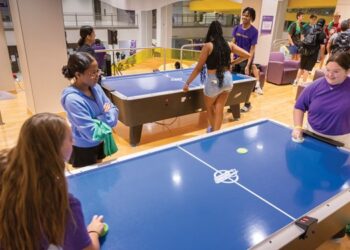You have a recreation center filled with fitness equipment, group exercise studios, basketball courts, a climbing wall and much more. But developing a balanced, healthy lifestyle involves more than physical activity. From demonstration kitchens, to nutritional coaching, to fitness assessments, an increasing number of universities are investing in programs and services that extend beyond the typical exercise umbrella you find.
According to Tammy Loew, the senior assistant director for wellness programs at Purdue University, providing programs that focus on overall wellness is aligned with the department’s central mission. “Wellness programs and services promote holistic wellness and positive health behaviors,” said Loew. “This fits very well within the vision of Purdue Recreation and Wellness, which is to be recognized as a leader in developing individuals to pursue lifelong wellness. We are very proud Purdue University supports this comprehensive approach.”
Purdue University Recreation and Wellness offers numerous programs to the campus community that promote a well-rounded view of health. Some of these programs include nutritional counseling services with a registered dietitian, cooking classes, massage therapy, a mindfulness series, and multiple education programs and tabling events with various health topics. This fall, the Mindfulness Series will cover topics such as stress reduction, yoga, meditation and mindful eating. A more unique offering is the light therapy room where light therapy is performed to treat Seasonal Affective Disorder (SAD) by providing exposure to artificial light.
It is crucial to remember fitness and wellness go hand in hand. It is not one or the other. Both have the same end goal, which is to help the students develop healthy habits they will maintain for the rest of their lives. “There are many opportunities to connect fitness and wellness together,” said Loew. “The personal trainers refer clients to our dietitian. The Mindfulness Series includes staff from fitness and wellness who talk about stress reduction, meditation, yoga and mindful eating. Our wellness programs on stress reduction, time management or sleep are promoted in fitness classes. Fitness and wellness work together.”
Over the past few years, Purdue University has made a concentrated effort to make wellness a priority. This included moving the wellness offices and programming from the Health Center to the Recreational Sports Center in 2015. This has allowed for greater cross-collaboration between the two entities, tying fitness and wellness even more.
“In the beginning, we were all finding our way together, but with the leadership team in our facility, it became evident very quickly that we all knew this would work, and it would work well,” said Loew. “What I thought would be a challenge ended up as a strength. We are now the Division of Recreation and Wellness.”
Virginia Tech has also made a concentrated effort to promote wellness on campus. As Shelly Rasnick, the wellness programs and student development coordinator at Virginia Tech explained, exercise is just a small part of developing a healthy lifestyle. “Wellness is more encompassing of how you can feel better overall,” said Rasnick. “There are pieces of exercise that are really important and impact how you feel in your day-to-day life. We find our students are stressed and might not be sleeping well, so they are not able to reach their full potential. I think showing them that to be healthy and successful involves so much more than just focusing on physical wellness, but also things like financial wellness or emotional wellness.”
Rasnick has worked to implement numerous innovative programs that help students address these various dimensions of wellness such as happiness workshops and even cooking classes. As she explained, exercise is a piece of wellness, but it is also important to address coping skills and stress management.
“One of our bigger programs is the Exercise as Medicine program,” said Rasnick. “We work with students through referrals from our counseling center or our health center. These are people with anxiety, depression or disordered eating. The activity helps them feel better, have more energy and hopefully feel happier in general.”
As both Rasnick and Loew outlined, there are numerous ways to incorporate wellness programming within campus recreation. Find creative ways to educate students about the importance of not only exercise but nutrition, stress management, meditation and more. Even if you do not have a dedicated wellness coordinator on your staff, don’t forget about partnerships across campus.
“If the Wellness Office/Health Promotion Office is in a different area of campus, I would encourage recreation staff to reach out to them,” said Loew. “Find ways to work together. Can you team up on specific projects? Can you share resources and information? And if campuses are considering bringing these two areas together, we’re happy to offer advice.”










